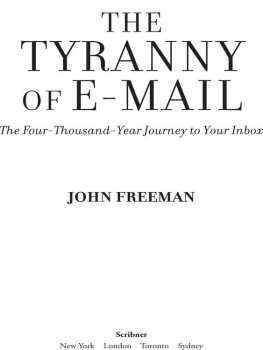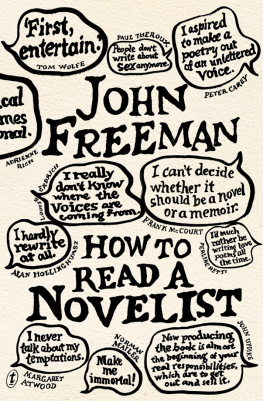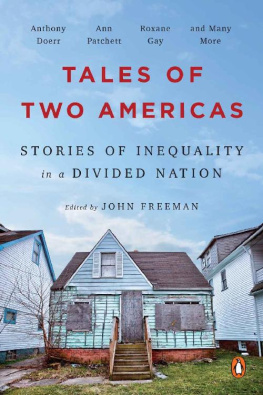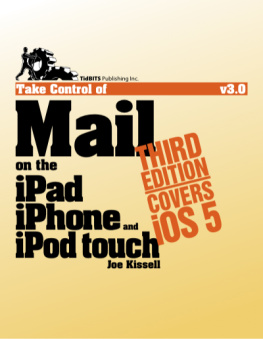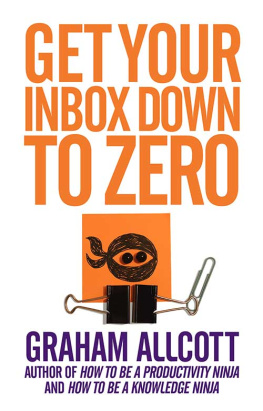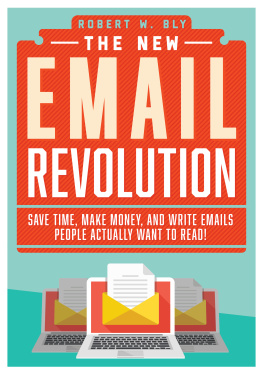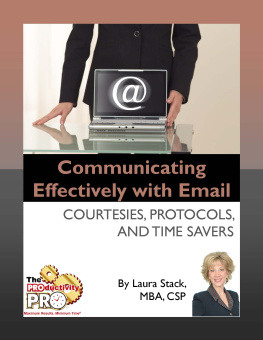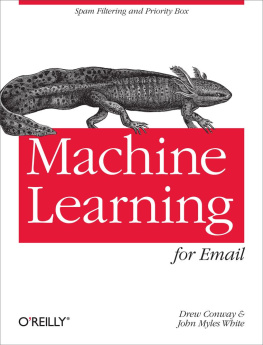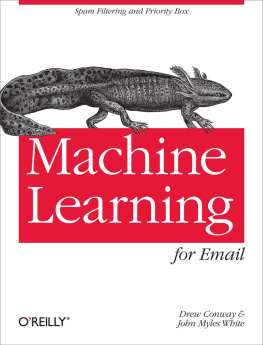
THE TYRANNY OF E-MAIL
The Four-Thousand-Year Journey to Your Inbox
JOHN FREEMAN


Scribner
A Division of Simon & Schuster, Inc.
1230 Avenue of the Americas
New York, NY 10020
www.SimonandSchuster.com
Copyright 2009 by John Freeman
All rights reserved, including the right to reproduce this book or portions thereof in any form whatsoever. For information address Scribner Subsidiary Rights Department, 1230 Avenue of the Americas, New York, NY 10020.
First Scribner hardcover edition October 2009
SCRIBNER and design are registered trademarks of The Gale Group, Inc., used under license by Simon & Schuster, Inc., the publisher of this work.
For information about special discounts for bulk purchases, please contact Simon & Schuster Special Sales at 1-866-506-1949 or business@simonandschuster.com.
The Simon & Schuster Speakers Bureau can bring authors to your live event.
For more information or to book an event contact the Simon & Schuster Speakers Bureau at 1-866-248-3049 or visit our website at www.simonspeakers.com .
Designed by Carla Jayne Jones
Manufactured in the United States of America
1 3 5 7 9 10 8 6 4 2
Library of Congress Control Number: 2009032087
ISBN 978-1-4165-7673-0
eISBN 978-1-4165-8812-2
Photographs on page 1 courtesy of Museum of Archeology, Istanbul; image on page 10 courtesy of the Print and Picture Collection, Free Library of Philadelphia; photograph on page 14 ThinkStock/Superstock; photograph on page 43 courtesy of Smithsonian Institution, National Museum of American History; photograph of H.L. Mencken on page 54 courtesy of Yale Collection of American Literature, Beinecke Rare Book and Manuscript Library; photograph on page 62 courtesy of Western Union Telegraph Company Records, Archives Center, National Museum of American History, Behring Center, Smithsonian Institution; photograph on page 70 courtesy of Photography Collection, Miriam & Ira D. Wallach Division of Art, Prints & Photographs, The New York Public Library, Astor, Lenox and Tilden Foundations; map on page 88 courtesy of Bolt, Beranek & Newman; photograph on page 92 courtesy of Leonard Kleinrock; photograph of William Burroughs on page 103 taken by Brion Gysin, reprinted with permission of The Wylie Agency LLC on behalf of The Estate of William Burroughs; image on page 125 courtesy of Aubrey Jones; photograph on page 190 Ingram Publishing/SuperStock; image on page 193: Samuel Yates, Untitled (Minuet in MG), 1999, mixed media, 15in. x 26in. x 65ft., Collection of Rene & Veronica di Rosa Foundation, Napa, CA. Photo by Ben Blackwell.
This book is for my grandmother, who wrote the most wonderful letters, and for my mother, who taught me how to reply
No man can be turned into a permanent machine. Immediately the dead weight of authority is lifted from his head, he begins to function normally.
MAHATMA GANDHI
CONTENTS
INTRODUCTION
The oldest love poem in the world sits behind a glass case at the Museum of the Ancient Orient in Istanbul, where it was placed on display on Valentines Day 2006. Carved in cuneiform, it rests on a clay tablet the size of a piece of toast, the script as small as bird tracks. Bridegroom, you have taken pleasure of me, the poet, a ghost lost to time, pleads in Sumerian. You have captivated me: let me stand trembling before you.
Love may not be forever, but this expression of it has outlasted swords forged by fire, cities designed by the finest architects, the largest machine ever to fly, and the most titanic boat ever to sail. To write his verse, the poet would have had to compose the lines in his head or recite them to a friend. Then he would have molded the clay tablet and slowly, but deliberately, carved his verse into it with a reed staff before the clay hardened. Finally, he would have dried the poem in the sun and waited another day for it to cool, when it could be delivered to his beloved by hand.
Feelings may not have a terminal velocity, but it should be said that certain expressions benefit from careful deliberation. Love is certainly one of them, but so is regret. So are longing, forgiveness, curiosity, and anger. Communicationthe conveyance of meaning from one person to the nextdepends on how we frame it. The second-most important question we must face, after choosing to communicate at all, becomes how to deliver what we want to say. Four thousand years after this poet bent over his writing desk, we have as many options as we have languages.
You can write your message in the sky, send it by singing telegram, speak into voice mail, shove it in the post, and hope for the best. You can write it in free verse, broadcast it to three hundred of your closest friends on Facebook, fire off an instant message, post it to your Twitter channel. If we think of modes of communication as a mirror spectrum of the human voice, we have as many registers as our mouths can make. The telex machine may have died, but most copy shops and offices still have fax machines. Phone booths still huddle, in various states of molestation, on many street corners. We can sign a message, pantomime it, text it, shoot a video message, record it as a song, upload a declaration of love onto YouTube, chalk it on pavement, scratch it on a tree trunk.
In his book The Gift, Lewis Hyde argues that one of the most effective ways to send a message into the world is to wrap it in a form that only it can possess and give it away. Why buy a card when you can make one? Why sermonize when you can write a sonnet? But how many of us have the time for thisor the skill? All over the world we are working longer hours than ever, sleeping fewer winks, taking shorter vacations. In this environment, frazzled and fried, tied to a machine that gazes back at us more hours per day than even our spouses do, we do what makes the most sense: we send our messages the fastest way possible.
The Inbox of Kings
In June 2004, the Internet giant Google made an announcement that quietly marked the apotheosis of the e-mail age. Gmail, its Web-based mail program, would offer users unlimited storage. Imagine for a moment what this means. Thanks to a group of 450,000 machines scattered across the United States like underground missile bunkers, I could store more e-mails than there are blades of grass in Kansas. This is beyond unprecedentedit is superhuman. Is Gods inbox this big? Prior to the electronic age, dictators and kings did not enjoy such epistolary armories.
Still, their capacity is dwarfed by the Herculean arms of an everyday individuals e-mail inbox today. What busy individual needs this industrial-strength capability for his correspondence tool? What buzzing, humming megalopolis tunes in to this techno-rave of send and receive, send and receive? Is the human brain wired to receive this much stimuli? Can our eyes scan this many separate pieces of information? Is anyone listening? Who is it behind the screens, tapping the bellows and pumping the organ keys of this huge, throbbing machine at all hours of the night?
For the Love of E-mail
The answer, of course, is us. We love e-mail. In 2007, 35 trillion messages shot back and forth between the worlds 1 billion PCs; in the time it took you to read to this point, some 300 million e-mails were sent and received. They sluiced down corporate drainpipes, piled onto listservs, promising a return on investment in a small African country and providing jokes about pigs and news about your grandmothers heart surgery. According to a Stanford University survey, 90 percent of all Internet users e-mail. In 2009, it has been estimated, the average corporate worker will spend more than 40 percent of his or her day sending and receiving some two hundred messages. Instead of walking down the hall, picking up the phone, or sending an interoffice memo, we e-mail.
Next page
